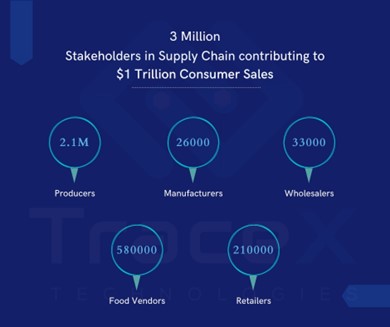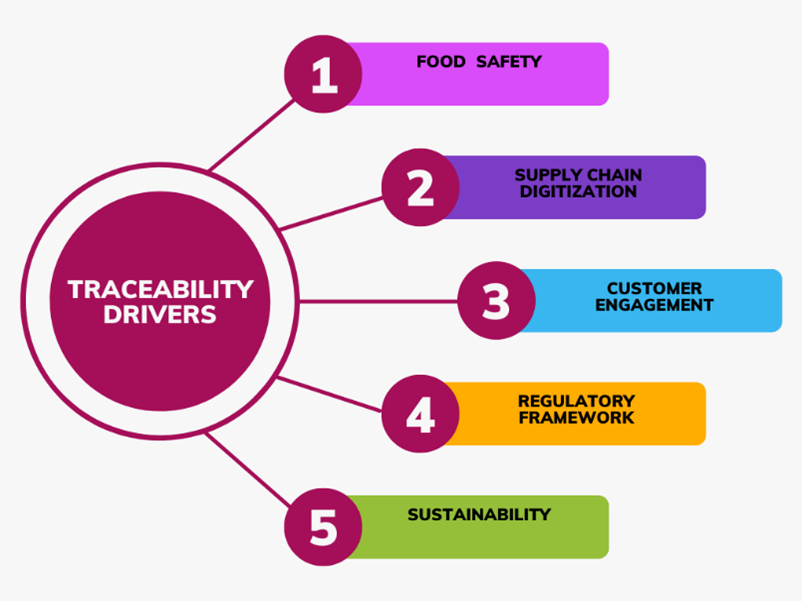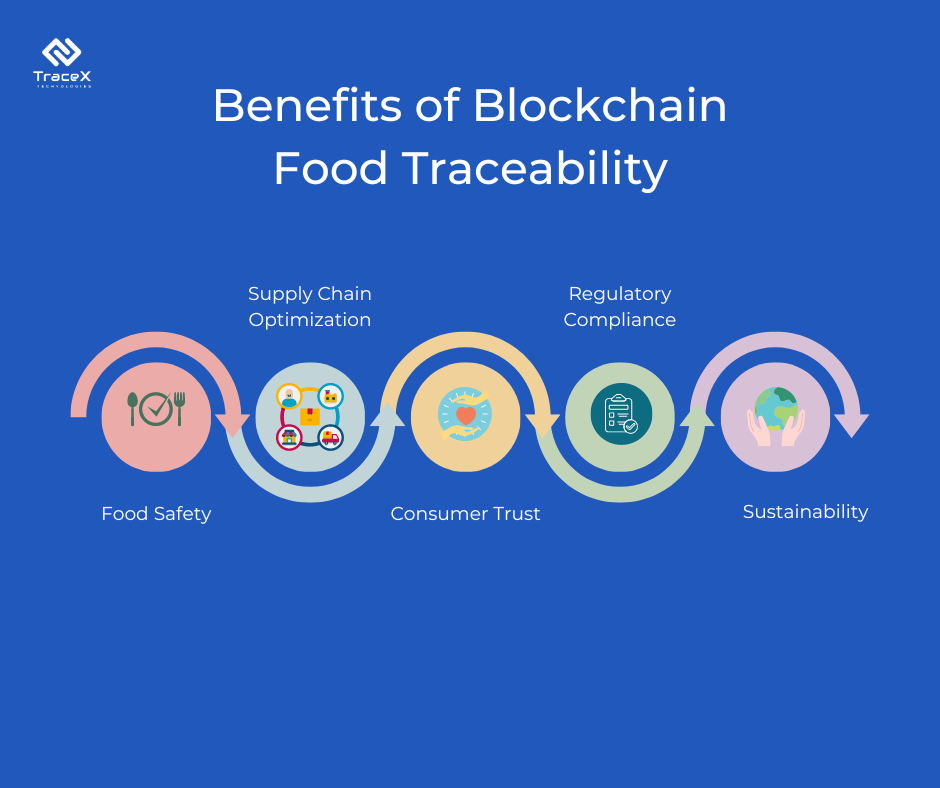Contact: +91 99725 24322 |
Menu
Menu
Quick summary: Blockchain, epitomized by solutions like TraceX, promises a food industry revolution. Ensuring transparency and security, it tackles safety, fraud, and inefficiency issues. From farm to fork, it offers visibility, enabling informed decisions and building a resilient, sustainable, and consumer-centric global food system.

In an era where food safety and transparency are paramount concerns for consumers and regulators alike, blockchain for food traceability emerges as a game-changer in ensuring the integrity of food products throughout the supply chain.
Consumers today want to know where their food comes from, how it was produced and the impact it has on the environment and communities. This pressing need has given rise to food traceability solutions that are transforming the food and agriculture industry. By leveraging advanced technologies and innovative solutions, food supply chain traceability is paving way for a more sustainable, ethical and resilient food system.
According to a survey conducted by the Food Marketing Institute. 75% of consumers consider transparency and traceability as important factors in their food purchasing decisions.
The food supply chain encompasses all the processes involved in producing, processing, packaging, transporting, and delivering food products to consumers. From agricultural production on farms to retail distribution in stores, the food supply chain is complex and involves numerous stakeholders.

Addressing these challenges requires collaboration among stakeholders across the food supply chain, adoption of innovative technologies such as blockchain and IoT, implementation of robust quality assurance and food safety measures, and commitment to sustainability and ethical practices.
Traceability is the ability to identify the origin of food and the feed ingredients in a supply chain. Traceability system allows a user to locate a product through the different stages of manufacturing, processing, distribution and handling of food from production to consumption.

Food traceability is crucial for ensuring the safety, quality, and authenticity of food products. Traceability systems enable stakeholders to track the origin, processing, and distribution of food items, allowing for swift identification and containment of foodborne outbreaks. Moreover, traceability enhances transparency by providing consumers with access to detailed information about the products they consume, including production methods, certifications, and sourcing practices.
Discover the roadmap to seamless food traceability!
Learn how to implement a 5-step approach for enhanced transparency and safety in your supply chain.
In recent years, high-profile food safety incidents and scandals have underscored the need for robust traceability systems in the food industry. By leveraging blockchain technology, food companies can establish end-to-end traceability, enabling them to quickly trace the source of contamination and implement targeted recalls. Additionally, blockchain enhances supply chain visibility, enabling stakeholders to identify inefficiencies, reduce waste, and optimize logistics operations. Blockchain is a decentralized digital ledger that records transactions across a network of computers in a tamper-proof and transparent manner. Each transaction, or “block,” is cryptographically linked to the previous one, forming a chain of blocks. This distributed ledger technology eliminates the need for intermediaries, reduces the risk of fraud, and enhances data integrity.
In the food industry, blockchain is utilized to create immutable records of food transactions, including the movement of products from farm to table. By digitizing and timestamping each step in the supply chain, blockchain enables stakeholders to trace the journey of food products in real-time. This level of transparency enhances accountability, facilitates rapid response to food safety incidents, and strengthens consumer trust.
Let’s delve into the unique features of blockchain—decentralization, immutability, and transparency—and how they address food traceability challenges:
Blockchain operates on a decentralized network of computers (nodes) rather than relying on a central authority. No single entity controls the entire system, ensuring resilience and trust.
Decentralization allows multiple stakeholders (farmers, processors, distributors, retailers) to participate in the same blockchain. Each participant contributes to the traceability data, creating a comprehensive view of the supply chain.
Decentralization reduces reliance on a single entity for information. Participants can verify data independently, enhancing trust and accountability.
Once data is recorded on the blockchain, it cannot be altered or deleted. Transactions are cryptographically linked, forming an unchangeable chain.
Food-related information (origin, handling, certifications) remains intact and tamper-proof. Immutability ensures that records are reliable and accurate.
In case of contamination or recalls, the immutable history helps pinpoint the exact source. Rapid identification minimizes health risks and financial losses.
All participants can view the entire transaction history on the blockchain. Transparency fosters openness and trust.
Transparent supply chains allow consumers to trace their food back to its origin. They can verify claims (e.g., organic, fair trade) and make informed choices.
Regulators can access real-time data, ensuring compliance with safety standards. Transparency simplifies audits and inspections.
In summary, blockchain’s features empower food traceability by creating a decentralized, tamper-proof, and transparent system. By leveraging these features, we can build safer, more accountable food supply chains.
Real-Time Tracking
Ensuring Authenticity
Examples of Quality Assurance
Reducing Paperwork
Faster Recalls
Optimized Logistics
In summary, blockchain transforms food traceability by enhancing transparency, ensuring product authenticity, and streamlining supply chain operations. By embracing these applications, we create safer, more accountable food systems.

TraceX’s blockchain solution, integrated with Trace Gro and Trace Pro, offers comprehensive end-to-end traceability throughout the food supply chain:
1. Pre-harvest Solution (Trace Gro):
– Trace Gro enables farmers and growers to digitize and manage pre-harvest activities such as planting, cultivation, and crop management.
– Through Trace Gro, data regarding crop cultivation practices, inputs usage, and environmental conditions are recorded on the blockchain.
– This information, including planting dates, fertilization schedules, and pest management strategies, is securely stored and timestamped, ensuring data integrity and transparency.
2. Post-harvest Solution (Trace Pro):
– Trace Pro focuses on post-harvest activities such as harvesting, processing, packaging, and distribution.
– It captures data related to product handling, processing facilities, transportation, and storage conditions, all of which are critical for ensuring food safety and quality.
– By recording post-harvest activities on the blockchain, Trace Pro establishes a transparent and auditable trail of product movements and transformations from farm to fork.
3. Blockchain Integration:
– The blockchain serves as a decentralized and immutable ledger that securely stores all data captured by Trace Gro and Trace Pro.
– Each transaction or data entry, whether related to pre-harvest or post-harvest activities, is cryptographically linked and time-stamped, ensuring its authenticity and preventing tampering.
– Stakeholders across the supply chain, including farmers, processors, distributors, retailers, and consumers, can access relevant information stored on the blockchain, thereby enhancing transparency and trust.
By combining Trace Gro and Trace Pro with blockchain technology, TraceX provides end-to-end traceability, enabling stakeholders to track the entire journey of food products from the field to the consumer. This seamless integration ensures data transparency, enhances food safety, mitigates risks, and fosters consumer confidence in the food supply chain.
In conclusion, blockchain technology holds immense promise for revolutionizing food traceability, offering unparalleled transparency, security, and trust throughout the supply chain. By leveraging blockchain solutions like TraceX, the food industry can address key challenges such as food safety, fraud prevention, and supply chain inefficiencies. With enhanced transparency and visibility into every stage of the food journey, from farm to fork, stakeholders can make informed decisions, mitigate risks, and ensure the integrity and quality of food products. As blockchain adoption continues to grow, it is poised to become an indispensable tool for building a safer, more resilient, and sustainable food system that meets the evolving needs and expectations of consumers worldwide.
